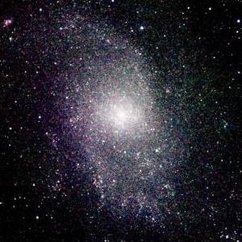Triangulum Galaxy
|
|
| Observation data | |
| Type | Sc |
| Right ascension (RA, α) (J2000,00) | 01 h 33.9 m |
| Declination (Dec, δ) (J2000,00) | +30° 39' |
| Distance from Earth | 2.4 million LY 0.73 Mpc |
| Apparent magnitude (V) | +5.7m |
| Apparent dimensions (V) | 73' x 45' (about 2.5 times the full Moon diameter) |
| Physical characteristics | |
| Mass (Sun = 1) | > 10-40 × 109 |
| Diameter | 50-60,000 light years |
| Other denominations | |
The Triangulum Galaxy (also known as Spiral Galaxy M33, Galaxy M33, Messier Object 33, Messier 33, M33, or NGC 598) is a spiral galaxy of type Sc located in the Triangulum constellation. Triangulum is small relative to its larger neighbors such as the Milky Way and the Andromeda Galaxy, but is about average compared to most spiral galaxies in the universe. Triangulum is a member of the Local Group of galaxies and may be a gravitationally bound companion of Andromeda. LGS 3, one of the small Local Group member galaxies, is itself possibly a satellite of Triangulum.
Andreas Brunthaler reported research in 2005 that showed the proper motion of the Triangulum Galaxy, from maser-produced radio emissions, to be approaching Andromeda at 190 km/s. This was the first measurement of the proper motion of any galaxy, and amounts to tens of micro-arcseconds per year.123
| Contents |
General information
Triangulum was probably discovered by Giovanni Batista Hodierna before 1654, who may have grouped it together with open cluster NGC 752. It was independently discovered by Charles Messier in 1764, who catalogued it as M33 on August 25. Triangulum was also catalogued independently by William Herschel on September 11, 1784, who assigned it the number H V.17. Triangulum was among the first "spiral Nebulae" identified as such by Lord Rosse.
Herschel also cataloged Triangulum's brightest and largest H II region (diffuse emission nebula containing ionized hydrogen) as H III.150 separately from the galaxy itself, which eventually obtained NGC number 604. As seen from Earth NGC 604 is located northeast of the galaxy's central core, and is one of the largest H II regions known with a diameter of nearly 1500 light years and a spectrum similar to the Orion Nebula.
This galaxy can be seen with the naked eye under exceptionally good conditions, and for most people is the most distant object visible.
References in fiction
In the fictional Star Trek universe, the Triangulum Galaxy is where the USS Enterprise is warped to after a being known as The Traveler uses his powers to influence the ship's warp drive. M33 is said to be approximately 2.7 million light years away from the United Federation of Planets territories. The galaxy was first encountered in the Star Trek: The Next Generation episode "Where No One Has Gone Before."
On Gene Roddenberry's Andromeda the Systems Commonwealth had territory in the Triangulum Galaxy in addition to the Andromeda and Milky Way Galaxies.
Related topics
References
- Note 1: Template:Web reference Paper 296KB PDF
- Note 2: Template:Web reference
- Note 3: Template:Web reference
External link
- Messier 33, SEDS Messier pages (http://www.seds.org/messier/m/m033.html)de:Dreiecksnebel
fr:Galaxie du Triangle it:Galassia del Triangolo nl:Driehoeknevel ja:さんかく座銀河 ru:Галактика Треугольника sv:Triangelgalaxen

